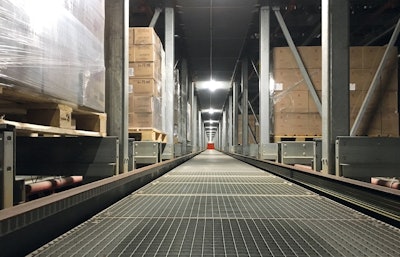
Meeting consumer demand and delighting customers are fundamental to building a competitive advantage in manufacturing and distribution. With modern advancements in supply chain and packaging technologies, companies in all verticals that may have once comfortably enjoyed their market share are facing more intense competition than ever. Industry veterans and newcomers alike are raising the stakes with competitive pricing and rapid order delivery offers.
The key to meeting demand, sustaining growth and future-proofing warehouse and distribution center operations lies in fully embracing automation, which frequently involves implementing automatic storage and retrieval systems (AS/RS).
The challenge of fulfilling orders is a classic Catch-22: The more orders are fulfilled, the faster expectations rise to fulfill orders. This means more products need to be consistently on hand, and in turn, more resources and capacity are needed to carry out operations and meet demand. Without support from automated warehousing solutions, there can be diminishing returns due to the limit on how quickly distribution center personnel can unload trucks, palletize and depalletize, drive forklifts, shelf and unshelf products and get shipments out the door to fulfill customer expectations.
AS/RS serve as highly versatile options and are growing in popularity and implementation. Growth within North America’s AS/RS market is projected at a compound annual growth rate of 9% through 2026. As these systems represent a significant investment and can redefine end-of-line operations, several factors should be taken into consideration before determining if they are right for your operation.
First, have a base understanding of how an AS/RS functions within a larger operation. These systems sit squarely in the intersection of logistics, robotics, and software, and use all three in conjunction to amplify the capabilities of warehouses and distribution centers. This versatility provides suitability for all types of warehouses, regardless of age, size and floorplan.
Second, it serves to know how the benefits of an AS/RS are directly derived from its components. The buildout itself consists primarily of modular shelving with high level capacities, navigated by an integrated network of powered carts and lifts that carry, store and retrieve pallets. The software behind the automation technology drives these systems, providing customizable logistics that empower any operation. This allows the AS/RS to navigate the unique logistics challenges of every respective industry and corresponding storage facilities, thereby improving inventory management, optimizing operational resources, and most importantly, meeting customer demand.
The software behind an AS/RS is robust enough to serve as the primary source of logistics automation for the entire facility, but is also adaptive and nimble enough to integrate with other third-party logistics software platforms. As storage needs frequently shift within facilities to meet supply, demand and product diversification, AS/RS are designed to grow and adapt with their users by adding additional modular components onto the existing setup, or adapting software to changing business dynamics.
Beyond the machinations of the system itself, you should consider how streamlining logistics for products with varying needs can improve your ability to deliver products in their intended, ideal condition. The speed and automation of retrieval, mixed with the logistics of the operation make it naturally efficient. For example, an AS/RS can automatically store the most frequently needed products, or those with the shortest shelf life, in areas for the fastest retrieval possible. Simultaneously, it can place items with a surplus at more remote areas of the facility, and automatically backfill these items from deep storage to easy picking zones as demand dictates. The algorithms that manage these decisions can be adjusted based on seasonality, portfolio changes, and other dynamics impacting product mix and priority.
The most cutting-edge innovations within AS/RS allow picker carts to move at higher speeds, handle pallets with heavier loads and operate in extremely cold environments – as low as -13°. Depending on your warehousing demands, these differentiating factors in AS/RS functionalities should be part of the decision-making process.
As powerful as these systems are, they can demand specialized service and ongoing upkeep. When considering the purchase of an AS/RS, confirm that manufacturers can provide not only seamless build outs, but also expertise in ongoing service and support from a preventative maintenance perspective. Vetting providers for expected availability to trained service professionals can help proactively minimize downtime and maximize ROI.
Beyond access to operational service and preventative maintenance, leading AS/RS practitioners are equipped to collaborate with clients to make sure your exact needs are incorporated from the outset. Every facility is influenced by industry, local and global factors that should be constantly monitored for ways to further improve utility.
Companies that carefully examine all these aspects before implementing an AS/RS are more likely to maximize productivity and profitability. Some have reportedly documented unprecedented growth numbers, with specific operations reporting an increase in units shipped by more than 450% after incorporating the AS/RS. Now is the crucial time to look to the future and to solidify your operation’s viability – and AS/RS can be the key.













![Pros To Know 2026 [color]](https://img.sdcexec.com/mindful/acbm/workspaces/default/uploads/2025/08/prostoknow-2026-color.mduFvhpgMk.png?ar=16%3A9&auto=format%2Ccompress&bg=fff&fill-color=fff&fit=fill&h=135&q=70&w=240)






